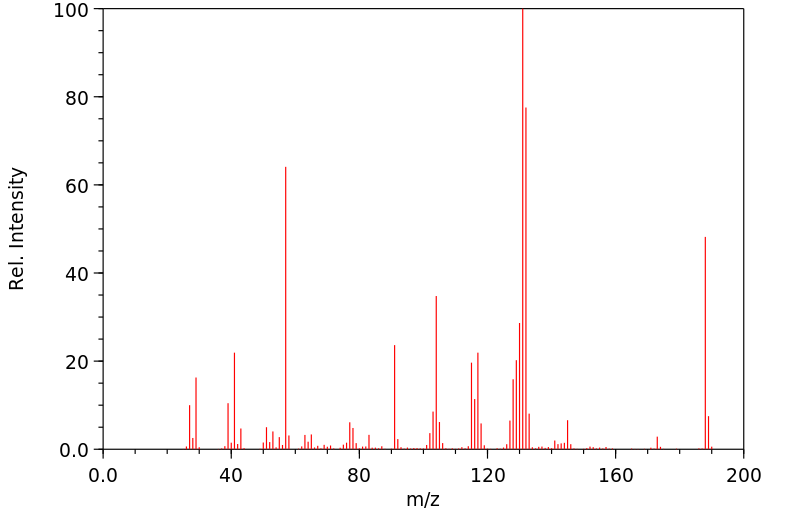2-(1,1-二甲基乙基)-1,2,3,4-四氢萘 | 42044-22-4
中文名称
2-(1,1-二甲基乙基)-1,2,3,4-四氢萘
中文别名
——
英文名称
2-tert-butyl-1,2,3,4-tetrahydronaphthalene
英文别名
2-tert-Butyl-1,2,3,4-tetrahydro-naphthalin
CAS
42044-22-4
化学式
C14H20
mdl
MFCD11616481
分子量
188.313
InChiKey
FCXYHCYNCWKCOS-UHFFFAOYSA-N
BEILSTEIN
——
EINECS
——
-
物化性质
-
计算性质
-
ADMET
-
安全信息
-
SDS
-
制备方法与用途
-
上下游信息
-
文献信息
-
表征谱图
-
同类化合物
-
相关功能分类
-
相关结构分类
物化性质
-
保留指数:1475
计算性质
-
辛醇/水分配系数(LogP):4.7
-
重原子数:14
-
可旋转键数:1
-
环数:2.0
-
sp3杂化的碳原子比例:0.571
-
拓扑面积:0
-
氢给体数:0
-
氢受体数:0
安全信息
-
海关编码:2902909090
上下游信息
-
下游产品
中文名称 英文名称 CAS号 化学式 分子量 3-(2-甲基-2-丙基)-3,4-二氢-1(2H)-萘酮 3-tert-butyl-3,4-dihydro-1(2H)-naphthalenone 42981-74-8 C14H18O 202.296 —— 2-tert-Butyl-3,4-dihydro-1(2H)-naphthalinon 42981-75-9 C14H18O 202.296
反应信息
-
作为反应物:描述:参考文献:名称:Duncan,W.P. et al., Synthetic Communications, 1973, vol. 3, p. 89 - 93摘要:DOI:
-
作为产物:描述:参考文献:名称:Duncan,W.P. et al., Synthetic Communications, 1973, vol. 3, p. 89 - 93摘要:DOI:
文献信息
-
Elimination−Addition Mechanism for Nucleophilic Substitution Reaction of Cyclohexenyl Iodonium Salts and Regioselectivity of Nucleophilic Addition to the Cyclohexyne Intermediate作者:Morifumi Fujita、Wan Hyeok Kim、Yuichi Sakanishi、Koji Fujiwara、Sayaka Hirayama、Tadashi Okuyama、Yasuhiro Ohki、Kazuyuki Tatsumi、Yasunori YoshiokaDOI:10.1021/ja0496672日期:2004.6.23intermediate. The cyclohexyne formation was confirmed by deuterium labeling and trapping to lead to [4 + 2] cycloadducts and a platinum-cyclohexyne complex. Cyclohexyne can also be generated in the presence of some other mild bases such as fluoride ion, alkoxides, and amines, though amines are less effective bases for the elimination. Kinetic deuterium isotope effects show that the anionic bases induce the E24-取代的环己-1-烯基(苯基)碘鎓四氟硼酸盐与四丁基乙酸铵的反应在非质子溶剂中得到ipso和cine乙酸盐取代产物。异构的5-取代的碘鎓盐也产生相同的异构乙酸盐产物混合物。该反应最好通过消除加成机制来解释,其中 4-取代的环己炔作为常见的中间体。环己炔的形成通过氘标记和捕获得到证实,导致 [4 + 2] 环加合物和铂-环己炔配合物。环己炔也可以在一些其他弱碱(如氟离子、醇盐和胺)的存在下生成,尽管胺是不太有效的消除碱。动力学氘同位素效应表明阴离子碱诱导 E2 消除 (k(H)/k(D) > 2),而胺允许在氯仿中形成环己烯基阳离子,从而导致 E1 和 S(N)1 反应(k(H)/k(D) 大约为 1)。碱在甲醇中的效果要差得多,而甲醇盐是唯一能有效提供环己炔中间体的碱。亲核试剂与环己炔反应以产生比例取决于环取代基的区域异构产物。观察到的取代环己炔亲核加成的区域选择性是从计算的 LUMO
-
Benzoannulation of ketones作者:Marcus A. Tius、Sadaquat AliDOI:10.1021/jo00137a026日期:1982.7
-
Chromic acid oxidation of indans and tetralins to 1-indanones and 1-tetralones using Jones and other chromium(VI) reagents作者:Radhika Rangarajan、E. J. EisenbraunDOI:10.1021/jo00214a007日期:1985.7
-
TIUS, M. A.;ALI, S., J. ORG. CHEM., 1982, 47, N 16, 3163-3166作者:TIUS, M. A.、ALI, S.DOI:——日期:——
-
RANGARAJAN, R.;EISENBRAUN, E. J., J. ORG. CHEM., 1985, 50, N 14, 2435-2438作者:RANGARAJAN, R.、EISENBRAUN, E. J.DOI:——日期:——
表征谱图
-
氢谱1HNMR
-
质谱MS
-
碳谱13CNMR
-
红外IR
-
拉曼Raman
-
峰位数据
-
峰位匹配
-
表征信息
同类化合物
(S)-(+)-5,5'',6,6'',7,7'',8,8''-八氢-3,3''-二叔丁基-1,1''-二-2-萘酚,双钾盐
顺式-4-(4-氯苯基)-1,2,3,4-四氢-N-甲基-1-萘胺盐酸盐
顺式-4-(3,4-二氯苯基)-1,2,3,4-四氢N-叔丁氧羰基-1-萘胺
顺式-1-苯甲酰氧基-2-二甲基氨基-1,2,3,4-四氢萘
顺式-1,2,3,4-四氢-5-环氧丙氧基-2,3-萘二醇
顺式-(1S,4S)-N-甲基-4-(3,4-二氯苯基)-1,2,3,4-四氢-1-萘胺扁桃酸盐
顺-5,6,7,8-四氢-6,7-二羟基-1-萘酚
顺-(+)-5-甲氧基-1-甲基-2-(二正丙基氨基)萘满马来酸
阿洛米酮
阿戈美拉汀杂质醇(A)
阿戈美拉汀杂质
钠2-羟基-7-甲氧基-1,2,3,4-四氢-2-萘磺酸酯
金钟醇
邻烯丙基苯基溴化镁
那高利特盐酸盐
那高利特
过氧化,1,1-二甲基乙基1,2,3,4-四氢-1-萘基
贝多拉君
螺<4.7>十二烷
蔡醇酮
萘磺酸,二癸基-1,2,3,4-四氢-
萘并[2,3-d]噁唑-2,5-二酮,3,6,7,8-四氢-3-甲基-
萘并[2,3-d]咪唑,2-乙基-5,6,7,8-四氢-(6CI)
萘亚胺
苯甲酸-(5,6,7,8-四氢-[2]萘基酯)
苯甲丁氮酮
苯甲丁氮酮
苯甲丁氮酮
苯并烯氟菌唑
苄基[(2S)-7-羟基-1,2,3,4-四氢萘-2-基]氨基甲酸酯
苄基-5-甲氧基-1,2,3,4-四氢萘-2-基氨基甲酸酯
苄基(1,2,3,4-四氢萘-2-基)胺
舍曲林二甲基杂质盐酸盐
舍曲林EP杂质B
舍曲林2,3-二氯亚胺杂质
舍曲林
羟甲基四氢萘酚
羟基-苯基-(5,6,7,8-四氢-[2]萘基)-乙酸
美曲唑啉
罗替戈汀硫酸盐
罗替戈汀杂质19
罗替戈汀杂质18
罗替戈汀杂质11
罗替戈汀中间体
罗替戈汀中间体
罗替戈汀
罗替戈汀
纳多洛尔杂质
米贝地尔(二盐酸盐)
硅烷,[3-(3,4-二氢-1(2H)-萘亚基)-1-炔丙基]三甲基-,(Z)-







